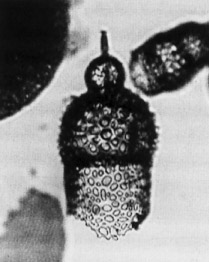 Theocorys
redondoensis (Campbell and Clark)
Theocorys
redondoensis (Campbell and Clark) Theocorys
redondoensis (Campbell and Clark)
Theocorys
redondoensis (Campbell and Clark)Theocyrtis redondoensis Campbell and Clark, 1944, p.49, pl.7, fig.4; Nakaseko, 1963, p.179, pl.2, fig.4
Theocorys redondoensis (Campbell and Clark) Kling, 1973, p.638, pl.11, figs.26-28
Shell large, with two sharp strictures, one of most beautiful species in this collection (its length four apertural, or two maximum diameters); apical horn occipital in origin but arising freely from cephalic vertex, gracefully curved, and distally pointed; cephalis distinctly globular and knoblike, set off sharply by distinct cervical suture from thorax below it, relatively large (0.3 maximum diameter of shell, and with its neck about a third of that diameter); thorax greatly exceeding other shell segments in prominence, very nearly perfectly hemispherical, greatest diameter, at its middle (0.5 total length), widely open at oral end, there squarely truncated, and outside, around thick rim that encircles base of abdomen, a row of short downwardly directed spines; abdomen taperingly subcylindrical with two sides unlike with local bulges and rather general asymmetry (its origin 0.32, and its opening 0.25 total length of shell), and distal end widely open but with a short, flared, entire lip, squarely truncated; wall of thorax thick, of cephalis a little thinner, and of abdomen membrane-like, latter readily torn cleanly off from remainder of shell so that majority of specimens appear formed of but two joints rather than three, and, in addition, horn is often torn off; surface of cephalis and of thorax roughened, latter much more so, otherwise shell glass-clear; pores of cephalis numerous, and very tiny, almost dotlike circles, very well separated, and in rather shallow depressions, freely scattered between surface tubercles, pores of thorax subuniformly circular, comparatively small for so large a species, perhaps as many as 75 around transverse axis, deeply sunken into hexagonal concavities or pits with blunt sepaloid points arising from frames; pores of abdomen subelliptical to subrectangular with rounded corners, freely scattered, not uniform in size but generally larger than those of thorax, perhaps a dozen in a vertical line and 20 around circumference, strikingly different from those of thorax (Campbell and Clark, 1944).
Length, total, 240 µm, of horn, 30 µm, of cephalis, 50 µm, of thorax 100 µm; diameter of thoracic maximum, 120 µm, of shell-aperture, 60 µm, of thoracic pores, 6.6 µm (Campbell and Clark, 1944).
T. redondoensis differs greatly in form, especially in large knoblike cephalis and inflated thorax from other described species (Campbell and Clark, 1944).
Prominent spherical, hyaline cephalis with sharp collar stricture. Thorax thick-walled and perfectly hemispherical.
According to Reynolds (1980) this species ranges from his early Miocene Cannartus violina Zone, which may be approximately equivalent to part of the tropical Cyrtocapsella tetrapera Zone to the lower part of the early Pliocene Sphaeropyle langii Zone of Foreman (1975).
Kling (1973) correctly pointed out that this species belongs in the family Theoperidae and not in the family Pterocorythidae.